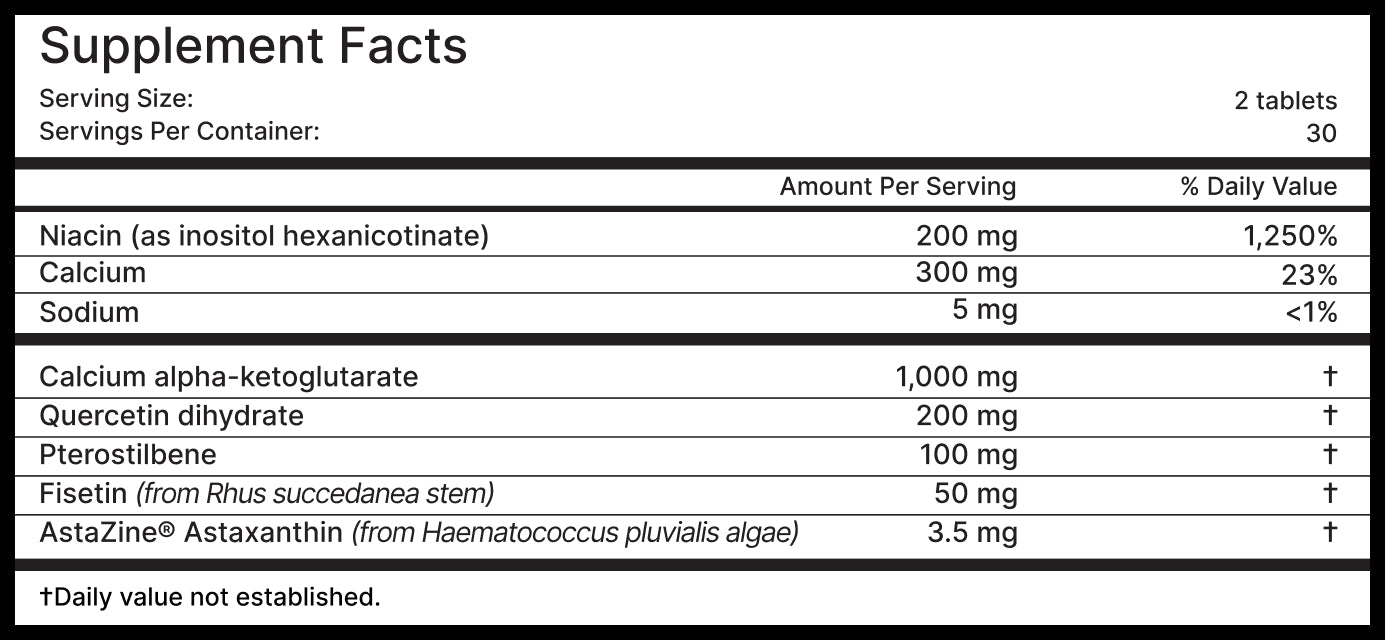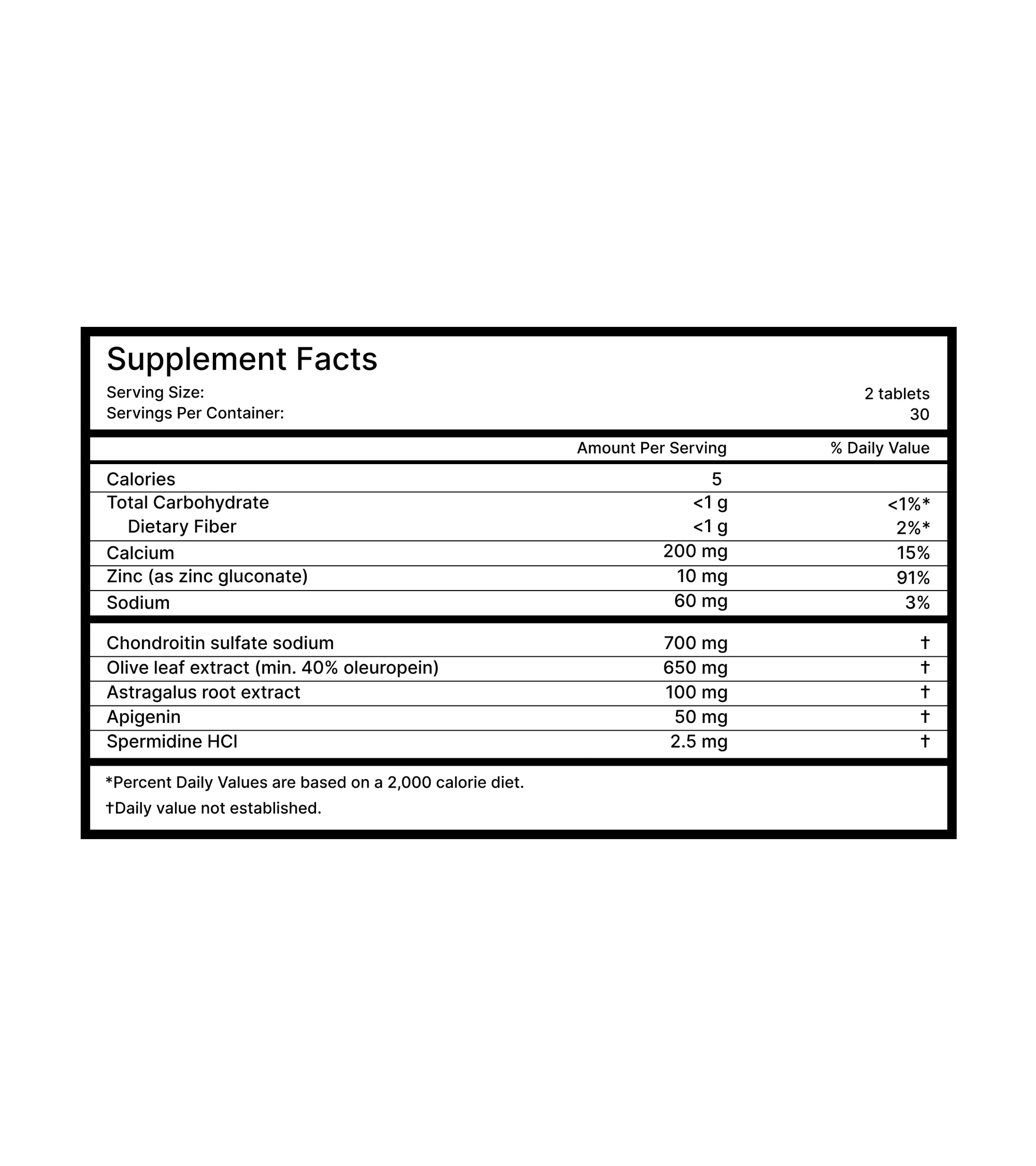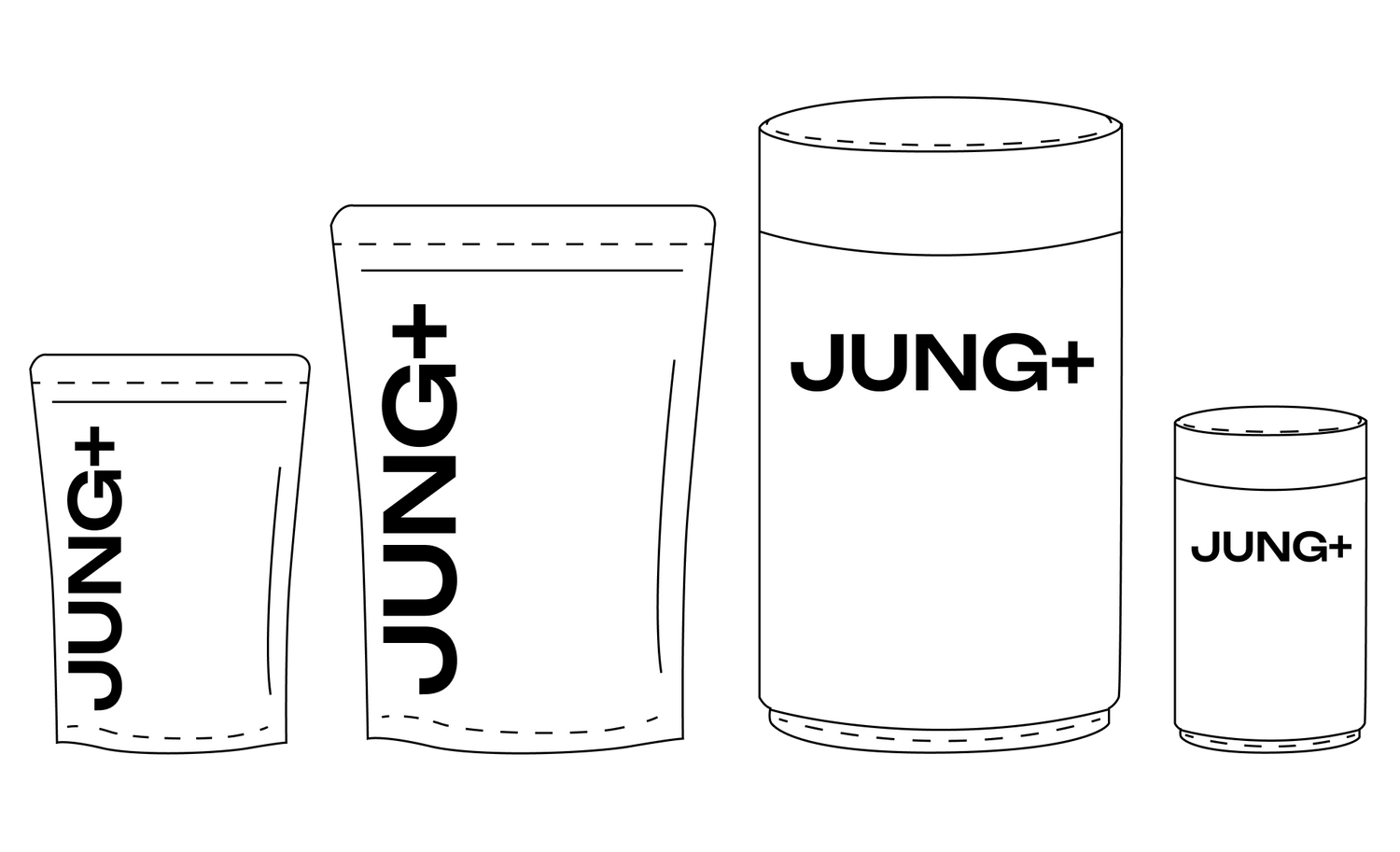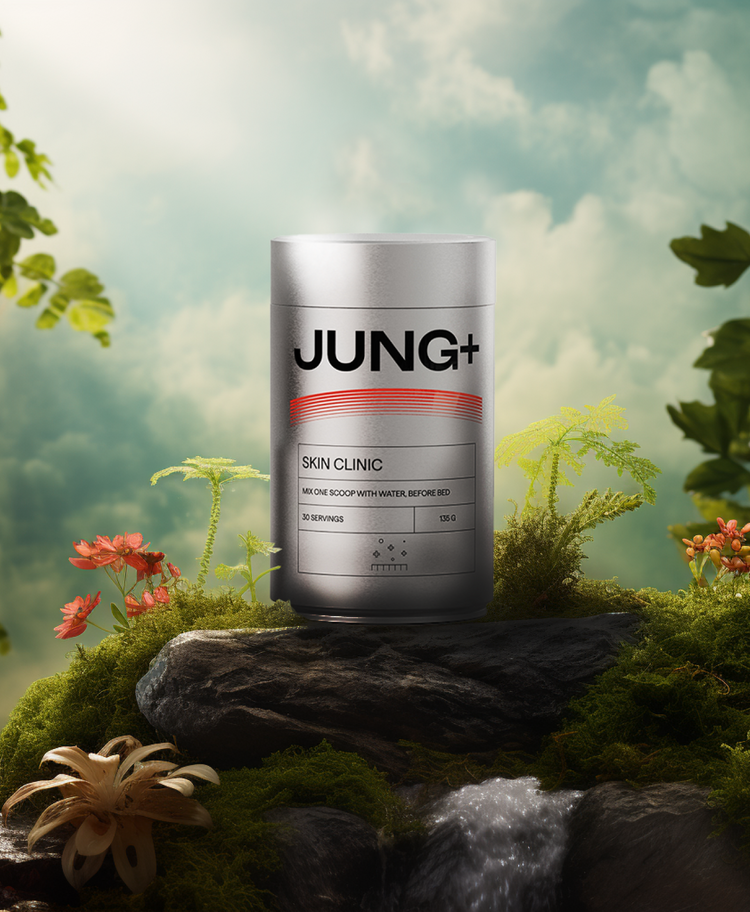Longevity Foundation
Welcome to the future of anti-aging. Devised by world-leading longevity experts, our foundational formula works around the clock to tackle aging at its roots, addressing all 12 known drivers of aging with precision. Our pioneering time-released AM/PM system, tailored to your body's natural rhythms, enables precision targeting, like having the guidance of a longevity clinician, 24/7. Formulated to modulate crucial longevity mechanisms like AMPK, mTOR, sirtuins signaling pathways, NAD+ levels, mitochondrial health, and cellular renewal, the combination helps support younger skin, a sharper mind, and a stronger body. With Longevity Foundation, you're challenging the very core of aging biology, with ingredients backed by 100+ studies.
Couldn't load pickup availability
As seen in
Two powerful formulas, one complete longevity regimen
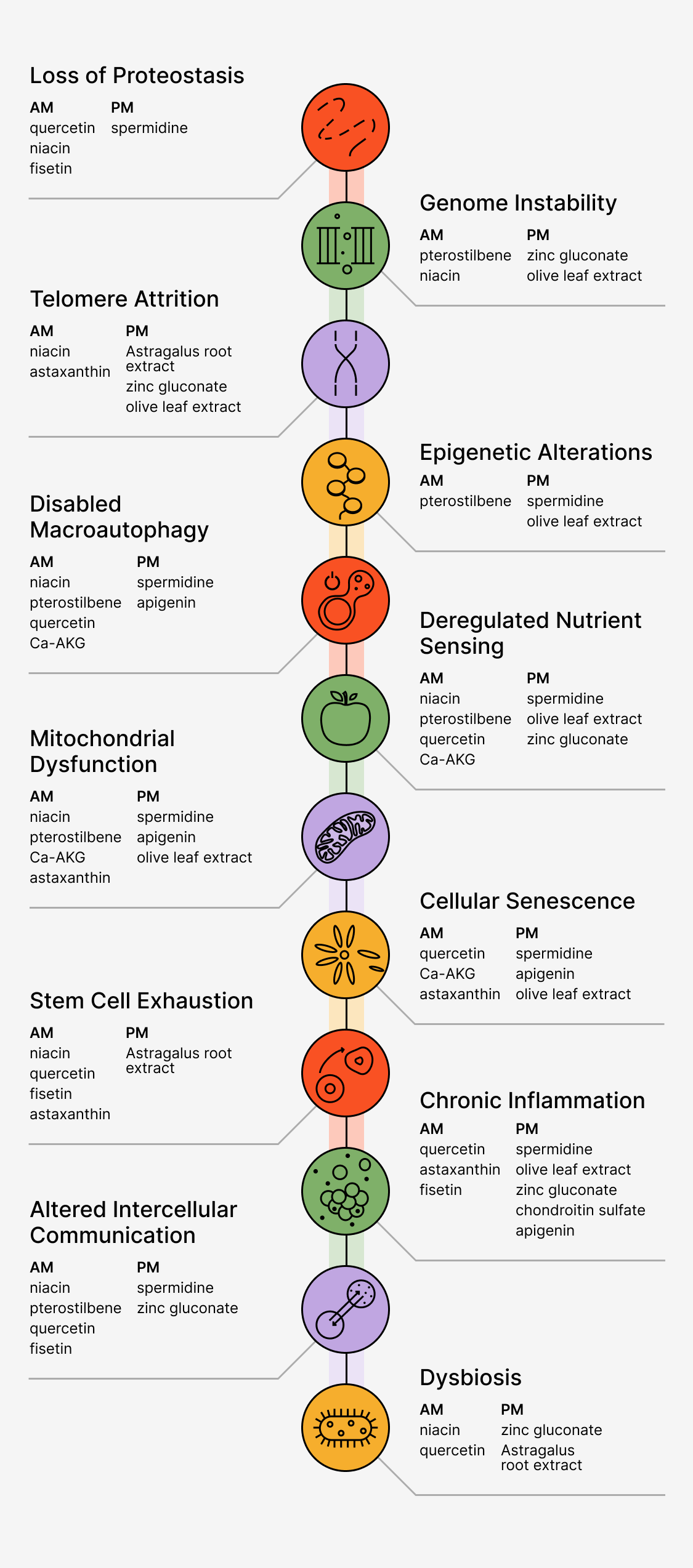

Why it’s different
-
Targets All 12 Hallmarks Of Aging
2-Part Formula with 24/7 Precision
-
Younger Skin From Within
Foundational Dermal Longevity
-
Multi-Modal Cellular Clean-up
Stimulates Autophogy, activates AMPK, mTOR, and SIRT1
-
Enhanced Cognition
With Sharp Days, and Calm Nights
-
Synergistically Boost NAD+
Move over, NMN
-
Strengthen Muscles, Nourish Joints
Because Movement Keeps You Young
-
Improved Cellular Energy & Vitality
Mitochondria Fuel & Metabolic Flexibility
-
Shield Cells From Oxidative Stress
Defy reactive oxygen species (ROS)
-
Fortify Immunity, Target 'Inflammaging'
A newly adopted Hallmark of aging
-
Supports Telomerase Activity
Protecting Shortened Telomeres, A Hallmark of Aging
-
Improved Gut Microbiome Balance
A newly adopted Hallmark of aging
How to use
you, like new
you, like new
you, like new
you, like new
you, like new
you, like new
you, like new
you, like new
you, like new
you, like new
you, like new
you, like new
you, like new
you, like new
you, like new
you, like new
you, like new
you, like new
you, like new
you, like new
you, like new
you, like new
you, like new
you, like new
you, like new
you, like new
you, like new
you, like new
you, like new
you, like new

Look inside
-
AM - Niacin
200 mg
Niacin, essential for energy production, DNA repair, and skin health, plays a vital role in cellular metabolism and longevity. It’s a well studied precursor to NAD+, a coenzyme essential for cellular processes. NAD+ declines with age. Unlike popular NAD+ boosters (NMN or NR), Niacin has been thoroughly studied in human trials for decades, and has been shown to cure NAD+ deficiencies in humans. It's also linked to heart health by lowering cholesterol, and to brain health by generating key brain chemicals. Our formula is engineered with a "no flush niacin" (inositol hexanicotinate), which provides niacin's benefits without the common flushing reaction, ensuring a steady conversion in the body to niacin and inositol (57, 79, 84, 85).
-
AM - Pterostilbene
100 mg
Pterostilbene, a naturally occurring compound found in blueberries and grapes, is known for its potent antioxidant, anti-inflammatory, and repair properties. It can also activate sirtuins, a family of proteins that help maintain the epigenome, and play a vital role in maintaining cellular health and extending lifespan, earning them the moniker "longevity genes". Pterostilbene is a cousin of ‘resveratrol’, which although popularly marketed, has unfortunately been found to be poorly-absorbable by humans, making pterostilbene (found to be bioavailable in humans) the superior choice. Additionally, some research suggests pterostilbene may aid in blood sugar control, crucial to healthy longevity (8, 16, 30, 73, 74). You would need to eat over 1 kg of blueberries to get a comparable amount of pterostilbene in Longevity Foundation.
-
AM - Quercetin
200 mg
Quercetin is a flavonoid with potent antioxidant properties found in various fruits and vegetables. It's known for its ability to scavenge free radicals, mitigating oxidative stress. Quercetin exhibits anti-inflammatory properties, helping to calm chronic inflammation - a Hallmark of Aging. Quercetin is considered a senolytic, which means it can clear senescent cells - another Hallmark of Aging - the zombie or damaged cells that no longer divide but contribute to inflammation and age-related diseases (9, 17, 28, 29, 87). Apples, onions, berries, capers, and leafy greens are particularly high in quercetin, but to reach 200 mg of quercetin in Longevity Foundation, you would need roughly 15 apples in a day.
-
AM - Calcium Alpha-Ketoglutarate
1,000 mg
Calcium Alpha-Ketoglutarate (Ca-AKG), plays an integral role in the body's metabolic processes, particularly the Krebs cycle, involved in energy production and nutrient metabolism. Ca-AKG reduces inflammation and supports cellular health, both key elements in promoting longevity. It may aid in removing senescent “zombie” cells that accumulate with age and can contribute to various aging-related diseases (89, 90). Alpha-ketoglutarate was shown to reduce biological age by 8.44 years for men and 6.98 years for women when measured by the TruAge DNA methylation test after an average of 7 months of use (91). AKG significantly extends the lifespan of C. elegans nematode be even 50% through inhibition of ATP synthase and TOR signaling (92).
-
AM - Fisetin
50 mg
Fisetin is a flavonoid polyphenol found in various fruits and vegetables. Fisetin is recognized for its potent antioxidant properties that help neutralize harmful free radicals and reduce oxidative stress, contributing to aging. Additionally, fisetin has senolytic properties, meaning it can selectively target and remove senescent or "zombie" cells. Thus, fisetin can potentially support longevity through its dual action of antioxidant and senolytic activity (11, 93-96). Fisetin may also mimic caloric restriction thanks to its sirtuin activation ability, and delays aging in fruit flies by 23% (97). To reach 50 mg of fisetin included in Longevity Foundation, you would have to consume 8.3 pounds of strawberries.
-
AM - Astaxanthin
3.5 mg
Astaxanthin, a naturally occuring carotenoid, is a red-pink pigment found in marine organisms like salmon, krill (and even flamingos!). Known as the queen of antioxidants, its power is up to 800x more potent than Co-Q10 or 6000x more powerful than Vitamin C, helping it combat oxidative damage, shielding age-accelerating damage at a cellular level. Astaxanthin contributes to cardiovascular health by reducing inflammation and oxidative stress in blood vessels, potentially protecting against neurodegenerative conditions like Alzheimer's and Parkinson's diseases by decreasing inflammation and oxidative damage in the brain. It is also beneficial for skin health, demonstrating a capacity to shield skin from UV light damage, minimizing wrinkles, and enhancing skin elasticity (12, 39, 101-103). Our Astaxanthin is sourced from Algae (which is where Salmon get it too).
-
PM - Spermidine
2.5 mg
Spermidine, a natural polyamine, has garnered significant interest for its potential impact on longevity and overall health. It promotes cellular renewal, supporting skin youthfulness through autophagy and brain health by removing damaged cell components, aiding cognitive function and possibly preventing age-related decline. Spermidine also maintains gut microbiome balance and intestinal health. Additionally, it offers cardiovascular benefits, potentially reducing heart disease risk by improving heart cellular health. Its role in longevity is linked to enhanced mitochondrial function and cellular metabolism, vital in aging (13, 26, 27, 32, 67, 98, 99).
-
PM - Zinc
10 mg
Zinc, vital for cellular metabolism, influences over 300 enzymes and 2,000 gene-controlling transcription factors. Essential for immune response, protein synthesis, wound healing, and DNA synthesis, it bolsters immunity, reduces inflammation, and enhances antioxidant activity, promoting longevity. Zinc deficiency can cause growth issues, weak immunity, skin disorders, and cognitive problems, highlighting its necessity for health (20, 21, 36, 105-107). Research indicates zinc may aid sleep regulation, making it part of our PM formula (108, 109). The zinc dose in Longevity Foundation is equivalent to about 1 kg of cooked chicken.
-
PM - Oleuropein (Olive Leaf Extract)
650 mg
Oleuropein (via Olive Leaf Extract), the main polyphenol found in extra virgin olive oil, mirrors one of the key benefits central to the Mediterranean diet. Oleuropein stimulates autophagy via the powerful AMPK/mTOR signaling pathway, the body's process of clearing out damaged cells, which can lead to better cellular health and longevity, as well as fights inflammation linked to age-related diseases, and may boost cognition and memory, protecting against cognitive decline (31, 41, 68, 111). This phenolic compound has powerful antioxidants, reducing oxidative stress, a major aging factor, and aiding in diminishing skin aging signs. It supports muscle health, metabolic disease protection, and is renowned in lowering blood pressure, showcasing cardioprotective and neuroprotective properties. Oleuropein lessens oxidative brain damage, counters Alzheimer's-related protein aggregation, and inhibits growth factors overexpressed in certain breast cancers (59, 69, 70, 110). A ‘High polyphenol’ olive oil is considered to have at least 250 mg of polyphenols per kilogram of olive oil - you would need to consume at least 2 kilograms of olive oil to receive the equivalent serving of Oleuropein in a single dose of Longevity Foundation.
-
PM - Astragalus
100 mg
Astragalus root extract, used in traditional Chinese medicine, is known for boosting immunity and potentially slowing aging at a cellular level. Its active components, astragalosides and polysaccharides, have anti-inflammatory and antioxidant properties. Studies indicate astragalus may protect telomeres, chromosome ends that degrade over time - a Hallmark of Aging - thereby influencing longevity (46, 112-114). Since immune response varies by time, its inclusion in our PM formula optimizes its effects. Astragalus also affects DAF-15/FOXO transcription factors in C.elegans, extending its lifespan by over 23% (115), highlighting its impact on longevity.
-
PM - Chondroitin
700 mg
Chondroitin sulfate, naturally in body cartilage, is recognized for its potential benefits in managing osteoarthritis symptoms. It enhances cartilage elasticity and resistance to compression, reducing joint pain and improving function. While its direct impact on longevity is subtle, promoting joint health and mobility contributes to optimized physical performance over time. In vitro studies indicate it may also reduce inflammation. Chondroitin sulfate is not typically found in significant amounts in the standard diet, and is primarily extracted for use in supplements (116-120).
-
PM - Apigenin
50 mg
Apigenin, a flavonoid commonly found in plants and herbs, possesses antioxidant, anti-inflammatory, and anticancer qualities. It promotes cellular homeostasis, crucial for cell health and function, countering stressors like inflammation and oxidative damage. Apigenin modulates cellular senescence and autophagy, key aging-related processes, and is involved in NAD+ metabolism, highlighting its role in maintaining cellular vitality (14, 24, 42, 121).
What are the 12 hallmarks of aging, how can they be addressed?
Learn more
Age is the single largest risk factor for an enormous number of diseases. So, if you can essentially postpone aging, then you can have beneficial effects on a whole wide range of disease.
Dr. Cynthia Kenyon, molecular biologist and pioneer in aging research
Scientific studiеs
-
By examining various studies and reports on the topic, it is evident that nicotinamide, the amide form of niacin, plays a crucial role in cell survival and longevity. Obtaining an adequate amount of vitamin B3 enhances the ability of nicotinamide to maintain cellular integrity and reduce inflammation. This process is achieved by influencing several cellular targets, such as mitochondrial membrane potential, poly (ADP-ribose) polymerase (PARP), protein kinase B (Akt), caspases, and microglial activation (122).
-
The study found that fisetin, a flavonoid present in many fruits and vegetables, is highly effective in combating cellular aging. Fisetin was the most potent among various flavonoids tested for eliminating senescent cells, which are cells that cease to divide and contribute to aging and age-related diseases. When administered to mice, both in models of accelerated aging and in normal aged mice, fisetin significantly reduced markers of cellular aging in various tissues and was effective with both short-term and intermittent treatments. Notably, fisetin's use in normal, aged mice led to improved tissue health, reduced age-related pathologies, and importantly, extended their overall lifespan, highlighting its potential as a therapeutic agent for aging and associated diseases (95)
-
Pterostilbene (PTS) has gained attention for its therapeutic potential in various diseases due to its improved absorption and stability compared to resveratrol. PTS shows promise in addressing conditions such as diabetes, cancer, cardiovascular disease, neurodegenerative disorders, and aging. This review highlights the nutraceutical potential of PTS and explores its mechanisms of action, focusing on its Nrf2-mediated effect in diabetes. It also discusses the sources of PTS, its pharmacokinetics, different formulations and administration routes used in studies and clinical trials, and strategies to enhance its availability and accessibility (73).
-
Spermidine, a natural polyamine found to decline with age, has emerged as a significant factor in promoting longevity. This groundbreaking study reveals that spermidine supplementation remarkably extends the lifespan of yeast, flies, worms, and even human immune cells. Moreover, it offers potent protection against oxidative stress in aging mice. The key to spermidine's efficacy lies in its ability to induce epigenetic changes, particularly the deacetylation of histone H3. This process, driven by the inhibition of histone acetyltransferases (HAT), leads to reduced oxidative stress and necrosis in aging yeast. On the flip side, reduced levels of endogenous polyamines correlate with increased acetylation, reactive oxygen species production, early necrotic death, and a shortened lifespan. Spermidine's impact extends to upregulating autophagy-related transcripts, thereby triggering autophagy in various organisms and human cells. This enhanced autophagy is essential for spermidine's role in suppressing necrosis and boosting longevity, underscoring its potential as a powerful anti-aging intervention (22).
-
This study investigates the anticancer effects of quercetin (QC) on the A-549 human lung cancer cell line. Researchers observed that QC notably inhibited cell growth in a dose-dependent manner and induced apoptosis, an effect that was even more pronounced with increased treatment duration. When examining the molecular mechanisms involved, the study found that QC treatment led to decreased expression of the anti-apoptotic gene bcl-2 and increased expression of the pro-apoptotic gene bax. These effects were also confirmed in vivo, using A-549 cell xenografts in mice, showing tumor growth inhibition and induction of apoptosis. Thus, the study concludes that QC's anticancer effects on A-549 cells may be attributed to its ability to regulate key genes involved in apoptosis (123).
-
The study investigated the relationship between dietary spermidine intake and mortality in humans. It involved 829 participants aged 45–84 years and used repeated, dietitian-administered food-frequency questionnaires over a period from 1995 to 2015. The results showed that all-cause mortality decreased with increasing spermidine intake. For instance, mortality rates per 1000 person-years were lower in groups with higher spermidine intake, corresponding to a reduced cumulative mortality incidence over 20 years. The hazard ratio (HR) for all-cause death per one standard deviation higher spermidine intake was significantly lower, suggesting a reduced risk of death with higher intake. This association was consistent across different subgroups and was also validated in a separate study. The study concluded that a diet rich in spermidine is linked to increased survival, with the mortality risk reduction between the highest and lowest spermidine intake groups comparable to being younger by approximately 5.7 years. This supports the idea that spermidine-rich nutrition can contribute to increased human longevity (98)
-
Alpha-ketoglutarate (AKG) is an intermediate in the Krebs cycle with diverse metabolic and cellular functions. It acts as an antioxidant, influencing nitrogen and ammonia balance and impacting epigenetic and immune regulation. These multifaceted properties suggest that AKG may potentially enhance human healthspan. Recent studies in worms and mice support this hypothesis. This review will focus on the regulatory role of AKG in aging and its potential as a treatment for age-related diseases (89).
-
Astaxanthin (ASX) is a natural compound that shows promising geroprotective properties. Its polyene chain allows it to scavenge free radicals in cell membranes and control oxidation. ASX has also been found to modulate various cellular mechanisms related to longevity, including the FOXO3 gene, a crucial regulator of cell function and longevity. ASX has shown neuroprotective effects, particularly in aging and neurodegenerative models, by increasing brain-derived neurotrophic factor levels, reducing oxidative damage, and preserving mitochondrial function. ASX can also influence proteins such as Nrf2, Sirt1, and Klotho associated with longevity. These findings suggest that ASX may have the potential as a geroneuroprotector (39).
-
Supplementation with olive leaf extract ameliorates age-related vascular and metabolic changes in Wistar rats.
This study analysed the impact of olive leaf extract (OLE), rich in secoiridoids and phenolic compounds, on aging-induced metabolic and vascular alterations in rats. The supplementation with OLE in aged rats showed a prevention of loss in body weight and muscle mass, and a reduction in the weight of adrenal glands. In terms of serum changes, OLE effectively lowered LDL-cholesterol and IL-6 levels, while increasing leptin and adiponectin concentrations. In the liver, OLE moderated the age-induced changes in gene expression, notably reducing the overexpression of NOX-4, Alox-5, iNOS, and TNF-α, and supporting the expression of SOD-1, GSR, GCK, and GSK-3β. Furthermore, OLE demonstrated a significant improvement in vascular function in aged rats, evidenced by the prevention of endothelial dysfunction, enhancement of vascular insulin resistance, and improved vasoconstriction response to KCl and NA. This improvement in vascular function was associated with the attenuation of alterations in the gene expression of key markers such as COX-2, IL-6, GPx, NOX-1, and IL-10. The study concluded that OLE exerts anti-inflammatory and antioxidant effects in aged rats and attenuates the alterations in vascular function associated with aging (124).
-
Astragalus membranaceus (Huangqi) is a medicinal herb used in traditional Chinese medicine for over 2000 years. It contains beneficial components such as polysaccharides, flavonoids, and saponins. Research suggests that Astragalus membranaceus extracts have antioxidant, anti-inflammatory, immunoregulatory, anticancer, and organ-protective effects and increase telomerase activity. This review focuses on its potential to extend lifespan, countering vascular and brain aging, and its anticancer properties. Understanding the mechanisms of Astragalus membranaceus could lead to the development of effective and targeted therapeutic agents against aging (112).
Your personal longevity kit, engineered for life
More than just a supplement, each product is a complete protocol and lifestyle program, synergistically formulated to work best together, and with ongoing use.
One-Time Purchase
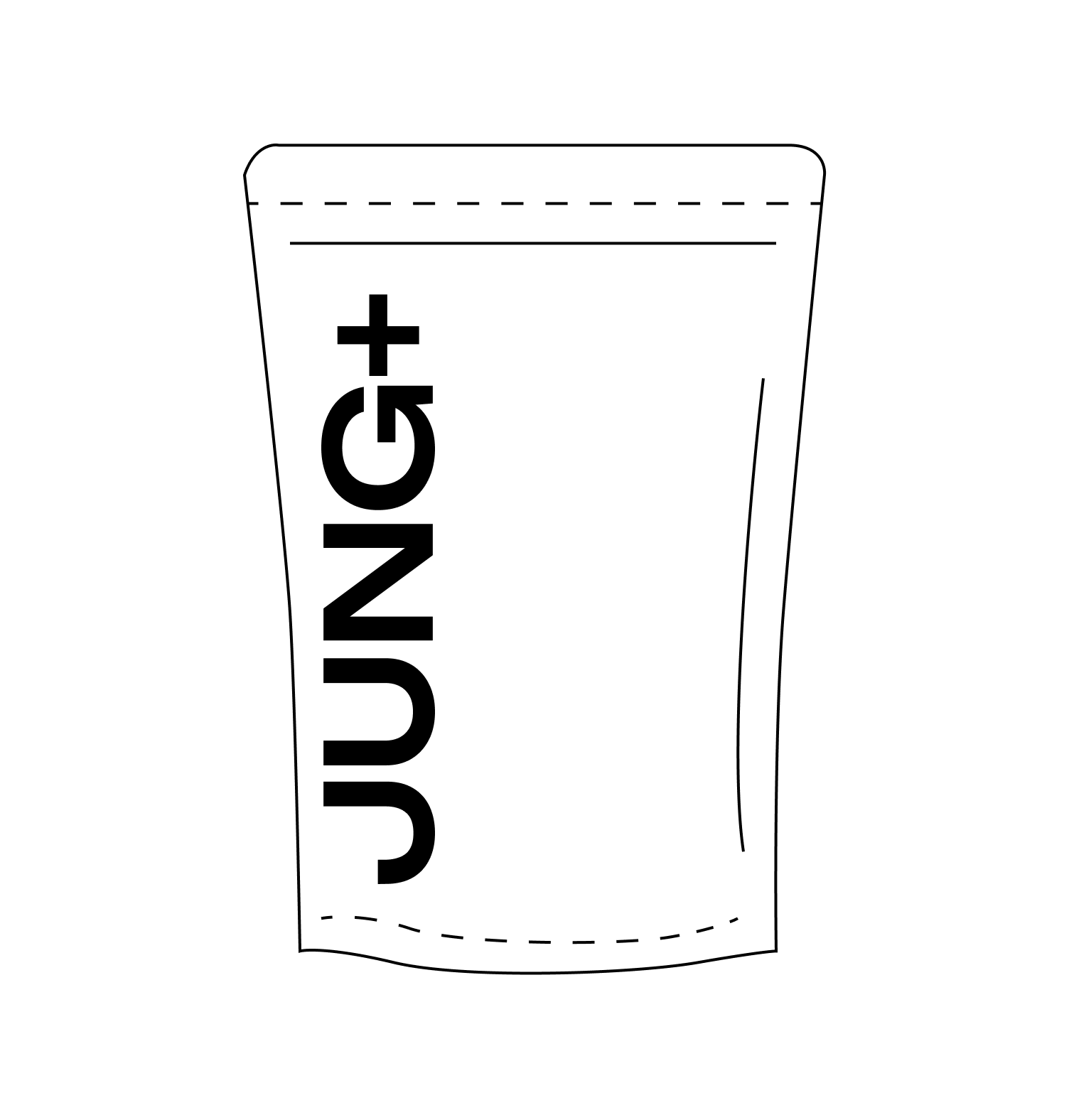
Receive a pouch filled with a one month supply of any product
Subscribe to unlock VIP benefits
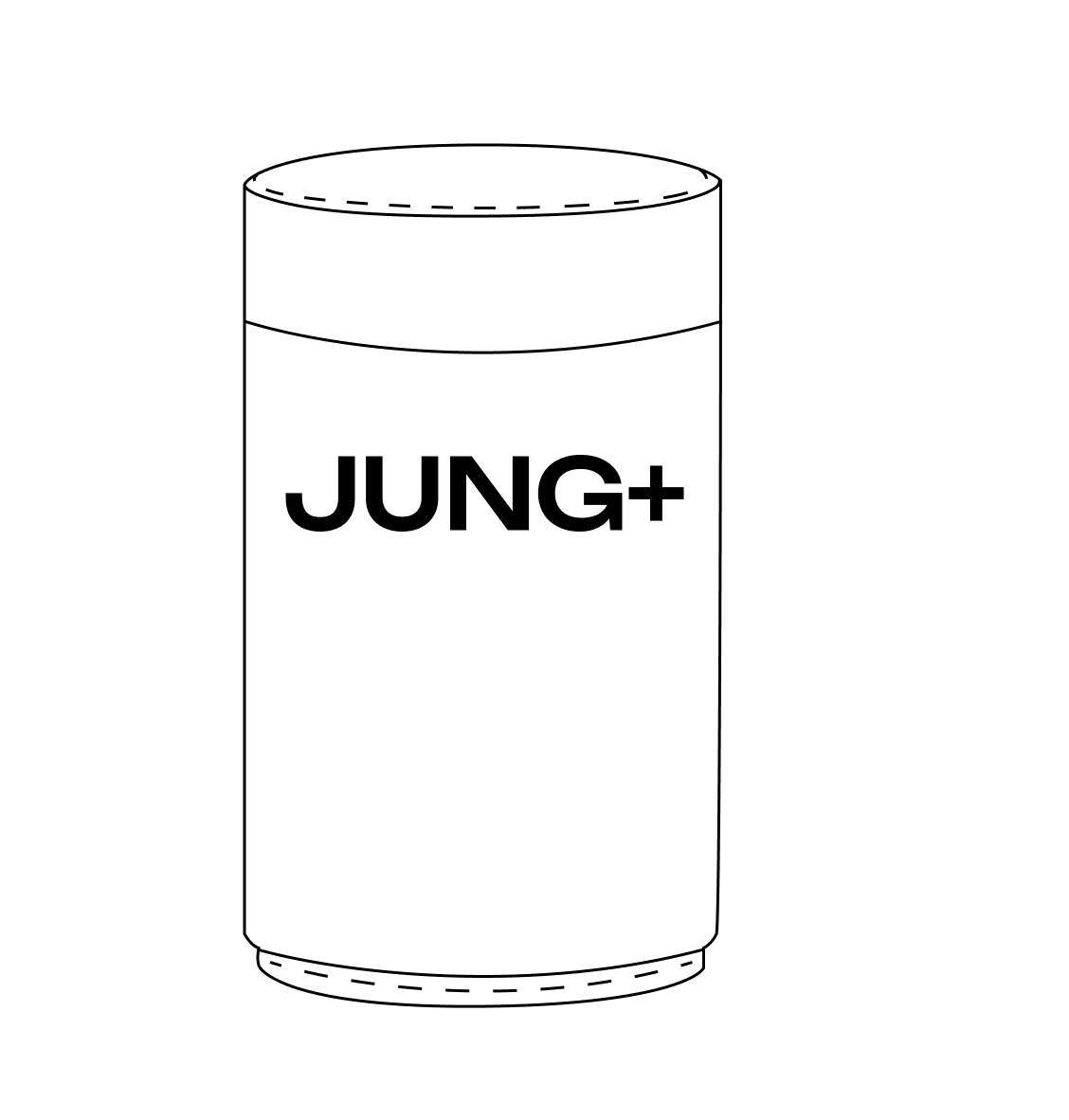
Your welcome kit includes a free storage canister to store your monthly delivery. 100% metal and recyclable, for you, and for the planet
+ Free coaching and scientific guidance, delivered straight to your inbox
+ Up to 30% off subscriptions, cancel anytime
+ White glove, subscribers-only access to the team for questions on your longevity protocol
+ Constantly updated formulas that track the latest science, so you don’t have to
+ First in line benefits for new products, special discounts, and features
Here's what our customers say
-
Feeling unstoppable
I forgot what it felt like to feel energized. I was so overrun with fatigue for many years that I just got used to it but once I started taking Jung, I began to feel more alert, have stronger performance both mentally and physically, and my mood elevated as well. In the gym, I was instantly able to lift more weights and feel that I was able to perform sprints more easily. I recover more quickly from the hard training that I do and overall, I feel fantastic!
-
Youth in a pill
Makes me feel amazing!
-
I feel like I have gotten younger
I simply feel like I have more energy to do everything. This is like a caffeine jolt without any of the side effects. I am hoping these results continue and build on what is currently happening? I'm willing to continue for a couple of months to find out.
FAQ’s
-
Can I use it as a replacement for my multivitamin supplement?
-
When will I see the first effects?
-
I'm feeling lazy. Can I take both AM + PM pills at once?
-
I forgot yesterday's dose. Should I take double the dose the next day?
-
Is this supplement all I need to live a longer, healthy life?
-
I'm pregnant! Can I continue taking the supplement?
-
I heard resveratrol is great for slowing aging - why didn't you include this?
-
I hear NMN is great for aging - why didn't you include this?
-
Why are the doses divided into morning and evening formulas?
-
I've heard of other longevity compounds. Why did you put them in other Jung+ formulas and not this?
100% Money Back Guarantee
At Jung, we believe in the power of our products and want you to feel confident in your purchase. That’s why we’ve partnered with Onward to offer an unmatched money-back guarantee. With Onward VIP Protection, your purchase is covered by a full money-back guarantee. If you’re not completely satisfied, simply return the product for a hassle-free refund.
100% Money Back Guarantee
References
-
Reference link
1. López-Otín C, Blasco MA, Partridge L, Serrano M, Kroemer G. The hallmarks of aging. Cell. 2013;153(6):1194-217.
-
Reference link
2. Lopez-Otin C, Blasco MA, Partridge L, Serrano M, Kroemer G. Hallmarks of aging: An expanding universe. Cell. 2023;186(2):243-78.
-
Reference link
3. Lemoine M. The evolution of the hallmarks of aging. Frontiers in Genetics. 2021;12:693071.
-
Reference link
4. Sies H, Berndt C, Jones DP. Oxidative stress. Annual review of biochemistry. 2017;86:715-48.
-
Reference link
5. Krumova K, Cosa G. Overview of reactive oxygen species. 2016.
-
Reference link
6. Romano AD, Serviddio G, De Matthaeis A, Bellanti F, Vendemiale G. Oxidative stress and aging. Journal of nephrology. 2010;23:S29-36.
-
Reference link
7. Munro D, Pamenter ME. Comparative studies of mitochondrial reactive oxygen species in animal longevity: technical pitfalls and possibilities. Aging Cell. 2019;18(5):e13009.
-
Reference link
8. McCormack D, McFadden D. A review of pterostilbene antioxidant activity and disease modification. Oxidative medicine and cellular longevity. 2013;2013.
-
Reference link
9. Deepika, Maurya PK. Health Benefits of Quercetin in Age-Related Diseases. Molecules. 2022;27(8).
-
Reference link
10. Liu S, He L, Yao K. The antioxidative function of alpha-ketoglutarate and its applications. BioMed research international. 2018;2018.





















